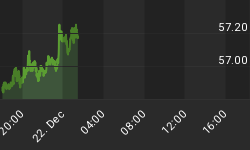LIBOR, the interest rates banks charge each other for short term lending has been rising lately. Curve Watchers Anonymous notes that 1-month LIBOR was 2.61% a month ago while today it is 2.90%.
LIBOR is normally close to the Fed Fund Rates which is sitting at 2.25%. Typically the spread would be something like 15 basis points not the 64 that you see. And with expectations of rate cuts coming, it should be dropping or steady, not rising.
Interest Rate Derivatives Suggest LIBOR To Rise Further
Eurodollar futures signal LIBOR to Rise Further and banks remain wary of lending.
Interest-rate derivatives are signaling that the rate banks charge for loans in dollars in London may rise further as financial institutions remain reluctant to lend.
The persistence of banks' need for cash and increase in Libor rates has triggered speculation that the Federal Reserve will increase, for the third time, the amount it loans through its Term Auction Facility, which is known as TAF. The Fed has auctioned a total of $360 billion in temporary funds through TAF since its debut in December. This month, both TAF auctions were for $50 billion each in 28-day loans.
The rate at this week's TAF was 2.87 percent, or 82 basis points above the minimum bid set by the Fed, the highest spread to date. An increase in the spread signals a rise in demand for funds in the banking system.
Fed Announces Another Auction
Speculation the Fed would act again was right on the money. Hoping to ease credit woes, Fed to auction another $75 billion in Treasuries.
The Federal Reserve announced Wednesday it will auction an additional $75 billion in super-safe Treasury securities to big investment firms, part of an ongoing effort to help strained credit markets. The auction -- the fifth of its kind -- will be held Thursday.
In exchange for the 28-day loan of Treasury securities, bidding firms can put up more risky investments, including certain shunned mortgage-backed securities, as collateral. In the four auctions held so far, the Fed has provided close to $158.95 billion worth of the Treasury securities to investment firms.
The goal is to make investment houses more inclined to lend to each other. It also is aimed at providing relief to the distressed market for mortgage-linked securities. Questions about their value and dumping of these securities had driven up mortgage rates, aggravating the housing slump.
Goal Fails Miserably
Interestingly enough, analysis posted on the Fed's own website shows why the program is doomed to fail. The conclusion of a Fed sponsored study was that banks and broker dealers will not make short term unsecured loans to each other when instead they can swap increasingly lousy paper with the Fed.
The above logic was presented in Failures of the Term Auction Facility and Fed's Swap-O-Rama Gets Crazier.
Regardless of what the Fed is thinking, a rational person would conclude that banks and broker dealers will pawn off as much garbage on the Fed as the Fed is willing to take. And so the Fed's own balance sheet is ballooning with garbage.
The latest H.4.1 Report, Factors Affecting Reserve Balances shows that of the $867 billion in reserve bank credit that is normally treasury bills and notes, approximately $319 billion has been swapped out.
Today, another $75 billion will be added to the swap-o-rama total. That will make the Fed's balance sheet look something like this: $394 Billion Garbage to $473 Billion Treasuries. One additional swap will make the Fed's balance sheet more than 50% garbage.
Is this supposed to restore confidence in the Fed? In the banking system? In the US dollar? Is this supposed to make institutions want to lend? Is the fact that the Fed is holding garbage instead of the banks supposed to make the securities more valuable?
Whatever the Fed thinks its pawn shop is supposed to accomplish, it clearly isn't doing it. After all, the Fed Is Not King Midas.
Besides, this pawn shop arrangement with non-banks is not even legal. Nonetheless, the Fed seems willing to pursue swap-o-rama till its balance sheet fills up. At the current rate that will be 3-4 more months. Swap till you flop? Is ZIRP next? Printing? Whatever it is, it won't matter. Banks and brokers are becoming increasingly zombified with each passing day.















